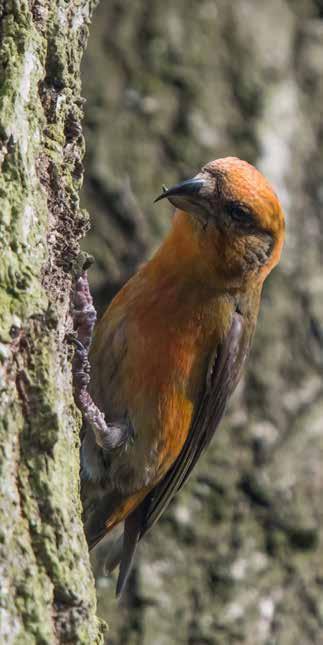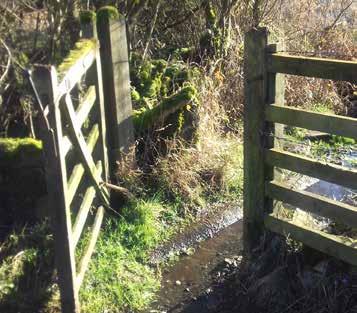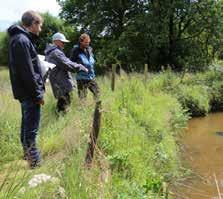
8 minute read
Beak of perfection – vibrant finches to look out for this autumn
Beaky finders
The waterside pines of the Upper Derwent Valley, Langsett and Longdendale are well-known hang-outs of the crossbill.
To make it through a Peak District autumn and winter, our resident and visiting birds need to be tough and adaptable. Tom Marshall takes a look at the tools of the trade of our resident and visiting finches, and shares where to track them down on your next visit.
When a beak and what you do with it can be the difference between survival and going hungry, then one group of birds can really show how it’s done. Well-known for their garden appearances and colourful attire, the finches can bring plenty to the table when it comes to making the most of autumn and winter’s bounty of feeding opportunities in the countryside.
Sometimes brute strength and size is what it’s all about (more on that later), but to kick off let’s take a look at one of our smaller diners, the siskin. Striking in its canaryyellow breast, striped belly, bottle green back and black cap, the siskin is a bird well worth looking out for to brighten a cold and dull winter’s day. Siskin are often found feeding alongside goldfinches and sometimes redpolls, and riverside alder trees and the pine plantations of the Upper Derwent Valley are among their favourite haunts. Their finely-pointed and delicate bill acts as a bespoke item of cutlery, allowing it to make short work of small seeds, out of reach of those with less dainty options. Once a regular

Hawfinch


on red-netted peanut feeders, they’re now equally content with the black sunflower seeds on offer at feeding stations such as those on the Longshaw Estate.
Whilst siskins are best looked for dangling acrobatically in the tree canopy, there’s still plenty to be had on the ground below, and a real winter treat can arrive in the shape of the brambling. A visitor from Scandinavia dropping in from November onwards, it’s easy at first glance to overlook the brambling as ‘another chaffinch’. When flocks take flight, however, their bright white rump sets them easily apart. Add to this a rather more orange plumage and, with early arrivals or late spring hangers-on, an almost all-black head, they can soon stick out amongst the flurry of feathers.
The seeds of mature beech trees or ‘mast’ are particular favourites, so scrutiny of ravenous mid-winter finch flocks may bring just rewards.
Another sought-after member of the finch family has become something of an enigma due to its rare and secretive nature, but those lucky enough to spot one in the leafless trees of winter will be confronted with an unforgettable sight. Our largest finch, the hawfinch also sports one of the most spectacular beaks, capable of exerting pressure equivalent to 150lbs per square inch. This nut-cracking prowess is thought to be capable of cracking cherry stones, although you’re equally as likely to see one skulking amongst the evergreen needles of yew trees, or hornbeams. Capable of appearing anywhere during harsh weather – including Bakewell gardens and the canal sides of the Cromford mills – their bold size and prominent white wing bars can be a useful giveaway in flight.

When it comes to being ‘top of the bill’, however, there is surely only one winner. With their unique crossed mandibles – the upper and lower parts of the beak – the aptly-named crossbill is peerless when it comes to feeding on the Peak District’s pine cones. This specialised tool allows the crossbill to prise open the cones, enabling them to access the seeds inside. Although

Siskin
such a feeding technique often finds them high in the tree tops, their seed-dominated diet also becomes thirsty work, demanding regular visits to pools, ponds or even rainfilled tracks.
The waterside pines of the Upper Derwent Valley, Langsett and Longdendale are wellknown hang-outs, and on sunny days the cherry-red of the males and alternative subtle green of the females can be an unexpected thrill above your head, or as you stumble across a group grabbing a quick drink ahead of you. With a strong seasonal reliance on the pine cone crops of northern Europe, in exceptional years our home-grown common crossbill can be joined by the super-sized beaks of the parrot crossbill, or the even rarer two-barred crossbill who have both found themselves at home in the National Park in recent years.
Where to go
Upper Derwent Valley (Fairholmes): Look out for siskins and the occasional redpoll in the waterside alders in winter, and carefully scan the finch flocks feeding between the visitor centre and the dam for bramblings. Crossbills can be found amongst the pines throughout the valley or dropping down to drink on track-side pools. National Trust Longshaw Estate: Bird feeders by the café are a regular stop off for wintering bramblings and siskin. Langsett, Yorkshire Water: Crossbills often feed amongst the pines here, including close to the car park, and the mixed woodlands around the reservoirs may also reveal siskins and perhaps the occasional brambling. Cromford Canal: Just outside the National Park, an early morning winter’s walk along the canal networks of Cromford could bring the treat of a hawfinch, but these striking finches can turn up almost anywhere with mature trees, with yew and hornbeam particular favourites.
PHOTOS: PDNPA Bridleway at Butterton, before repair.


Bridleway repairs benefit riders, walkers, wildlife and water quality
Our Countryside Maintenance and Projects Team (CMPT) worked with Staffordshire County Council, our ecologists and rights of way team to repair two sections of a bridleway.
At Butterton, the bridleway crosses a watercourse, exceptional for its water quality and wildlife. An old board walk and stepping stones, which were almost unusable, were replaced with a new flagstone crossing. It will help protect wildlife in the brook. A newly installed bridlegate and drainage works will mean
Financial support is available to farmers and land managers in the South West Peak to help improve water quality and natural flood management of the Upper River
Dove, River Hamps, River Churnet and
Meerbrook.
The Upstream Thinking project includes a range of work to help reduce pollution, remove invasive non-native species, and create new habitats.
Farms eligible for the Upstream
Thinking project could benefit from a farm water and soil plan, and capital works to improve water quality.
Grants are available until September 2021, supported by the European
Agricultural Fund for Rural Development through the South West Peak Landscape
Partnership (complementing funding from the National Lottery Heritage Fund). Bridleway at Butterton, after CMPT’s repairs. the bridleway is fit for use for years to come.
At Grindon, the team created two new crossings over ecologically important watercourses. They cleared scrub to restore the bridleway’s original line and installed new signs and gates along the 2km route.
The team built a stone-bridged culvert over a wet area, previously almost impassable, and created new wetland to increase habitat. They also made a ford for horses to cross the brook safely, walkers’ feet dry!
Upstream thinking for cleaner water
maintaining an existing footbridge to keep
PHOTO: SWPLP

Farm Link Workers discuss water quality with the landowner.
• To find out more, please email SWP@peakdistrict.gov.uk, or phone Andy Farmer on 07973 848384 or Dave Cooper on 07970 312531. Old field barns are distinctive landscape features.

Minor repair grants for field barns
Small grants are currently available for minor repairs to conserve traditional field barns in the South West Peak. To be eligible, barns must be in agricultural use, structurally sound, and built before WW1. The aim is to stop their deterioration before barns require full restorations at a much higher cost.
Minor repairs may include work to doors, windows, rainwater goods, minor roof repairs like slipped tiles, and repointing.
The deadline for applications has been extended to 30 November 2020.
For more information, please contact Catherine Parker Heath, the South West Peak Landscape Partnership’s cultural heritage officer, email: SWP@peakdistrict.gov.uk, or phone: 01629 816279 or 07970 237129.
WINTER OPENING HOURS

More time to cycle
It is safe to say we have had one of our busiest years on record, welcoming thousands of you to our traffic-free trails. We have provided bikes for all sizes, ages and abilities and as we approach the Winter season, we want to continue the good spirit and extend our opening hours longer than ever before. So whether you’re planning a weekend excursion, or perhaps looking ahead to Christmas and New Year activities, we’re here for you.
ASHBOURNE BIKE HIRE CENTRE
Time Open from
10am-3.30pm/4.30pm*
10am-3.30pm/4.30pm* ASHBOURNE Mapleton Lane, Derbyshire DE6 2AA
01335 343156 ashbourne.cyclehire@ peakdistrict.gov.uk Days
Thu-Sun
2 Dec**
27 Dec
Open until
26-29 Nov
28 Dec
DERWENT BIKE HIRE CENTRE
Time Days Open from
10am-3.30pm/4.30pm*
10am-3.30pm/4.30pm* Weekends
Daily 2 Dec**
27 Dec
Open until
19-20 Dec
31 Dec
*Dependent on daylight hours. Please confirm with a member of the team when hiring. ** Or in line with Covid-19 government lockdown restrictions.
Sun-Mon
PARSLEY HAY nr Buxton, Derbyshire SK17 0DG
01298 84493 parsleyhay.cyclehire@ peakdistrict.gov.uk
DERWENT Fairholmes car park, Derwent, Bamford S33 0AQ
01433 651261 derwent.cyclehire @peakdistrict.gov.uk
MANIFOLD VALLEY Hulme End, Hartington SK17 0EZ










